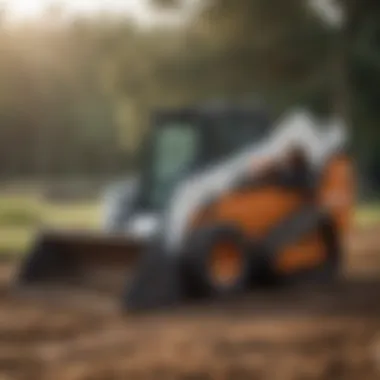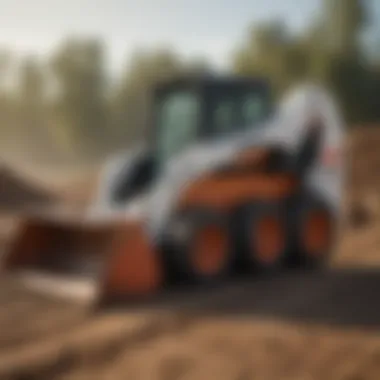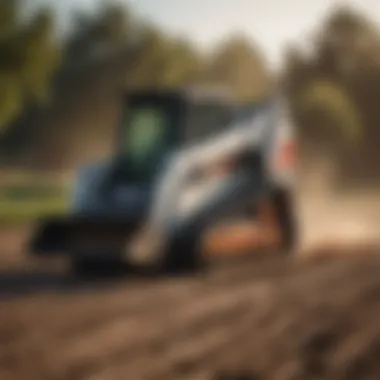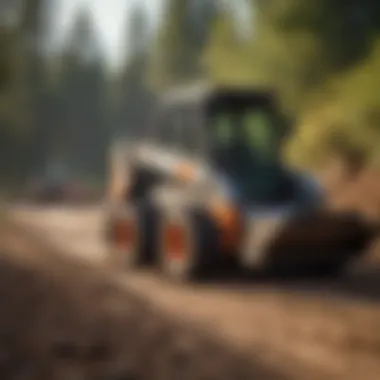Bobcat Skid Steer Sizes Chart: A Comprehensive Guide


Intro
Bobcat skid steers are crucial tools in agriculture. They provide versatility in handling various tasks. However, choosing the right size can be complex. Understanding the specs of each skid steer is essential for optimizing performance in farming and horticulture. This guide will explore sizes, applications, and best use cases for each model.
Overview of the Topic
Definition and Importance
A Bobcat skid steer is a compact, multi-purpose machine. It is often equipped with a front-mounted loader. These machines are essential for lifting, digging, and pushing materials in agricultural settings. Their performance can greatly enhance productivity when used correctly. Farmers and horticulturalists must consider the size of the skid steer matching their specific needs. The wrong size can lead to inefficiency and increased operational costs.
Current Trends
Recently, there has been a shift in agriculture toward automation and more efficient equipment. The demand for larger skid steers with advanced features is rising. Technological advancements are improving operational capabilities. Compact models are also gaining popularity, as they provide flexibility in small spaces. Understanding these trends is vital for making informed equipment choices.
Key Techniques and Practices
Step-by-Step Guide
- Assess Needs: Identify the tasks that the skid steer will perform. This helps determine the appropriate size and model.
- Research Specs: Look into the specifications of each Bobcat model. Pay attention to lifting capacity, dimensions, and weight.
- Consider the Terrain: Evaluate the environment where the skid steer will operate. Rough terrain may require a more robust model.
- Test Models: Whenever possible, test different models. This can provide valuable hands-on experience.
Tools and Equipment Needed
To effectively use a Bobcat skid steer, consider the following tools:
- Attachments for digging, lifting, or hauling
- Maintenance tools for daily upkeep
- Safety gear including helmets and gloves
- Fuel and lubricants for optimization
Challenges and Solutions
Common Obstacles
Some challenges with skid steers include:
- Overloading the machine, leading to potential damage
- Not using the correct attachments for tasks
- Underestimating maintenance needs, which can cause breakdowns
Innovative Solutions
To overcome these challenges:
- Always adhere to the load capacity guidelines. This will prolong the life of the machine.
- Choose attachments tailored for specific tasks. This increases efficiency and performance.
- Schedule regular maintenance checks. This ensures smooth operation and reduces downtime.
A well-informed choice of Bobcat skid steer can significantly impact productivity in agricultural practices. Selecting the right size and understanding its usage is crucial for success.
Prelims to Bobcat Skid Steers
Bobcat skid steers are essential machinery in modern agriculture. Their compact design allows for versatility on various job sites. These machines can maneuver easily in tight spaces. Their significance extends beyond mere operation; they represent efficiency and productivity in farming and landscaping.
Understanding Bobcat skid steer models is imperative before making a purchase. With different sizes available, each serves specific functions. Choosing the right model can drastically affect workflow and output.
Skid steers are equipped with powerful engines, capable hydraulic systems, and numerous attachments. For farmers and agricultural enthusiasts, knowing how to select the correct skid steer can lead to optimal performance in various tasks. This guide aims to provide valuable insight into skid steer sizes. Evaluating specifications helps to visualize their application in real-world scenarios.
"Selecting the appropriate Bobcat skid steer involves more than just size; it is about matching the machine to the task at hand."
In summary, this section lays the foundation for a comprehensive understanding of Bobcat skid steers. It addresses their essential role in agricultural processes and prepares readers for the detailed information ahead.
Understanding Size Categories
Understanding the varying size categories of Bobcat skid steers is crucial for making informed decisions about which model meets specific operational needs. Each size category offers distinct capabilities and limitations that can significantly influence overall productivity. Properly assessing these categories not only helps in selecting the most suitable skid steer but also ensures that tasks are performed efficiently and effectively.
When considering a Bobcat skid steer, it is essential to take into account the nature of the work, the environment it will operate in, and the potential for attachment compatibility. Optimal machine size can lead to increased maneuverability in tight spaces, while larger models provide greater power and lift capabilities for more demanding tasks. Understanding these size categories allows users to match equipment to their unique requirements, thereby minimizing downtime and avoiding unnecessary expenditure.
Compact Skid Steers
Compact skid steers are typically designed for smaller tasks and confined spaces. With a narrower frame and lighter weight, they offer agility that is unmatched in tighter environments. These machines are beneficial for various applications such as landscaping, small-scale agricultural work, and residential projects.
Key features include:


- Maneuverability: Their smaller size permits easy navigation in narrow zones, like backyards or along fences.
- Weight: Lighter than their larger counterparts, making them suitable for jobs on delicate surfaces like lawns or driveways without causing damage.
- Versatile Attachments: Compact skid steers can be equipped with a range of attachments such as buckets, rakes, and forks, allowing for diverse job capabilities.
Compact skid steers are ideal for users who require a dependable, yet powerful machine that fits comfortably into limited working areas.
Standard Skid Steers
Standard skid steers represent a middle ground in size and power. They offer a balance of maneuverability and performance, making them suitable for a wider array of tasks. This category is often favored for general construction, medium-scale agricultural operations, and various landscaping projects.
Important aspects of standard skid steers include:
- Power: Equipped with more powerful engines compared to compact models, allowing for enhanced productivity.
- Load Capacity: The increased operational weight enables them to handle heavier loads, thus extending their range of uses.
- Versatility: With a large range of compatible attachments, they can perform tasks ranging from grading to demolition.
These machines serve as excellent choices for those seeking a reliable skid steer with enough power to handle intermediate tasks while still maintaining some degree of maneuverability.
Large Skid Steers
Large skid steers are built for heavy-duty applications. They have robust engines and higher load capacities, making them suitable for demanding tasks within construction, farming, and other industrial environments. Their design focuses on maximizing power and efficiency.
Key features of large skid steers include:
- High Capacity: Capable of lifting and moving significant loads, which is advantageous in construction or material handling.
- Stability: The added weight and wider wheelbase provide improved stability when operating on uneven terrain or during lifting tasks.
- Enhanced Features: Many models include advanced hydraulic systems that enable greater performance with various attachments.
While large skid steers are not as nimble as their smaller counterparts, their power and capacity make them a necessity for operators involved in larger projects requiring substantial muscle.
Key Specifications of Bobcat Skid Steers
Understanding the key specifications of Bobcat skid steers is crucial for anyone looking to make the right choice in equipment. These specifications not only dictate the capabilities of the skid steer but also influence how effectively it can be utilized in various tasks within the agricultural sector. Each specification plays a significant role in determining productivity and efficiency, making it essential to grasp their implications before making a purchase or rental decision.
Engine Power and Efficiency
The engine power of a Bobcat skid steer is a fundamental aspect that directly affects performance. Generally, higher horsepower translates to an improved capacity to handle heavy workloads and challenging terrains. For instance, operators may find that models with more power deal better with demanding tasks such as lifting heavy materials or pushing through dense mud.
In addition to power, fuel efficiency is an equally important consideration. Efficient engines allow for prolonged operation without frequent refueling. This is especially beneficial on larger agricultural sites. By comparing the fuel consumption of various models, potential buyers can find a balance between power and efficiency to suit their needs.
Operating Weight
Operating weight is another key specification that merits attention. It is a measurement of how heavy the skid steer is, which influences its stability and lifting capabilities. A greater operating weight typically allows for a more stable base, enhancing the skid steer’s effectiveness on uneven surfaces. However, it is important to consider that heavier models may be more challenging to transport.
When selecting a skid steer, it's critical to evaluate the maximum lifting capacity relative to the skid steer's size and weight. Understanding these aspects will help in making informed decisions, preventing damage to crops, and ensuring optimal machinery use.
Hydraulic System Performance
The hydraulic system is at the heart of a skid steer’s functionality. It is responsible for powering various attachments and executing multiple tasks such as lifting, digging, and pushing. A performant hydraulic system can dramatically increase the versatility of a skid steer by allowing a range of attachments to be used effectively.
Factors to inspect include the operating pressure and flow rate of the hydraulic system. Higher flow rates can lead to quicker attachment operation and, consequently, more efficient work cycles. By investing in a skid steer with a robust hydraulic system, agricultural professionals can ensure they are prepared to tackle diverse challenges efficiently.
"Choosing the right skid steer hinges on understanding these key specifications. It shapes the operational efficiency you can achieve in your agricultural tasks."
In summary, the key specifications of Bobcat skid steers offer invaluable insights for farmers and agricultural enthusiasts. Paying close attention to engine power, operating weight, and hydraulic performance translates to improved productivity and adaptability in various agricultural contexts.
Detailed Size Chart for Bobcat Skid Steers
The detailed size chart for Bobcat skid steers is an essential theme in understanding how to select the appropriate machine for various agricultural tasks. Capturing the subtle differences between compact, standard, and large skid steers enables users to make informed choices based on the specifics of their needs. It serves as a foundation from which operational efficiency can be optimized. Knowledge of size specifications helps farmers navigate through potential challenges in usage, enhancing their productivity while minimizing operational costs.
Chart Overview
This section provides an overview of the characteristics detailed in the size chart. The chart includes critical specifications such as engine power, operating weight, and hydraulic capacity. It summarizes key metrics that influence the skid steer’s performance on the job. Understanding these parameters allows users to gauge which machine appropriately matches their operational requirements.
Key features of the chart:
- Engine specifications for power assessment
- Weight considerations affecting mobility and stability
- Dimensions that influence fitting in workspaces
By examining these data points, users can correlate equipment specs with the specific demands of their agricultural environment.
Size Comparison


Compact vs. Standard vs. Large
The compact, standard, and large skid steers each serve distinct purposes within agricultural applications. Their size greatly dictates their maneuverability and capacity for handling loads.
Compact skid steers are ideal for narrow spaces and offer excellent agility. Their size does not compromise their power, allowing them to perform in tight areas such as gardens or smaller farms.
Standard skid steers strike a balance between size and functionality. They provide competent lifting capabilities while maintaining good mobility. These models are popular for various tasks, including landscaping and general maintenance operations.
Large skid steers are powerful machines designed for heavy-duty work. They can handle larger loads, making them suitable for major construction projects or expansive agricultural operations.
Each size category exhibits specific advantages and disadvantages crucial for task evaluation. Compact skid steers excel in agility, while large types boast raw power but may struggle in tight quarters.
Understanding these differences aids users in making a well-informed decision tailored to their operational demands. Being aware of the unique capabilities of each category can lead to enhanced productivity and minimized operational hindrances.
Choosing the Right Size for Your Needs
When it comes to selecting the appropriate Bobcat skid steer for agricultural tasks, understanding your specific needs is paramount. The right size not only influences operational efficiency but can also affect overall productivity. Deciding on the size involves several factors, including the types of tasks you expect to perform, the weight capacity required, and the maneuverability needed.
For instance, larger skid steers may offer more power and lifting capacity, ideal for heavy-duty jobs. However, they might not fit well in tight spaces. Conversely, compact models can easily navigate limited areas but may lack the power for larger tasks. Therefore, analyzing the distinct characteristics of the work environment and job requirements is crucial.
The effectiveness of a skid steer is heavily reliant on matching the equipment size to the task at hand.
Assessing Task Requirements
Identifying the precise task requirements is the first step in choosing the right Bobcat skid steer model. Each task may demand different capabilities, including lifting capacity, hydraulic power, and reach. For example, excavation or grading typically requires a skid steer with a higher operating weight and robust hydraulic systems. In contrast, tasks like hauling dirt or light landscaping might be well-suited for a smaller model that is easier to operate.
Here are some specific points to consider when assessing task requirements:
- Lifting Capacity: Ensure that the skid steer can safely lift and transport the materials involved in your tasks.
- Hydraulic Needs: Determine if additional hydraulic power is necessary for the attachments you plan to use.
- Speed and Agility: Consider whether rapid movements are essential for your operations.
By closely aligning your skid steer choice with these requirements, you can maximize productivity and reduce the risk of equipment failure.
Evaluating Terrain
The nature of the terrain where the skid steer will be used is another critical factor. Different terrains present various challenges, including surface type, slope, and overall accessibility. Compact models may excel on smooth or flat ground, providing maneuverability and ease of operation. However, for uneven or rugged terrain, a larger skid steer with a wider wheelbase can offer greater stability and power.
Consider the following when evaluating your terrain:
- Surface Type: Assess whether you will be working on asphalt, gravel, mud, or farmland. Skid steers designed for specific surfaces can improve efficiency.
- Slope: For hilly or inclined areas, choose a model with better traction and stability features to gain confidence and safety during operation.
- Accessibility: Analyze the physical space constraints. If navigating through narrow paths or between structures is necessary, a smaller model may be preferable.
Choosing the proper skid steer size entails careful consideration of both task requirements and the terrain. By evaluating these elements diligently, agricultural professionals can select a Bobcat skid steer that effectively meets their operational needs.
Applications of Bobcat Skid Steers
The applications of Bobcat skid steers are vast and varied, making them essential tools in many industries. Understanding the specific uses of different sizes can help organizations maximize their efficiency and productivity. Bobcat skid steers serve a significant role in agricultural tasks, landscaping projects, and construction activities. By comprehending these applications, users can better select their equipment according to their needs, ensuring optimal performance.
Agricultural Use
Bobcat skid steers find a critical place in the agricultural sector. They are capable of handling various tasks effectively, making them invaluable on farms. For instance, skid steers are often employed for loading and transporting materials like soil, crops, and fertilizers. Their compact size allows them to maneuver in tight spaces, which is useful in cultivating land that may be difficult to access.
Some common agricultural tasks include:
- Soil leveling and grading
- Transloading materials
- Loading hay bales
- Clearing brush or debris
Using attachments such as forks, buckets, and tillers, skid steers can adapt to meet various needs on a farm. This versatility allows farmers to increase their productivity with efficient equipment that saves both time and labor costs.
Landscaping Projects
In landscaping, Bobcat skid steers are equally valuable and widely used. They can aid in numerous activities from site preparation to landscape installation. When landscaping, precision is often required, and skid steers deliver that control. They can perform tasks like grading, digging, and moving heavy materials in a compact footprint.
In addition, the ability to switch between attachments like landscape rakes, backhoes, and augers enhances their usability. With a Bobcat skid steer, landscapers can streamline operations, particularly in residential and commercial landscaping designs. This adaptability ensures that every project, big or small, can be executed in an organized and effective manner.
Construction Activities
Construction sites benefit greatly from the incorporation of Bobcat skid steers. They are capable of navigating through rough terrain and confined job sites, offering a solution to multiple challenges in construction. Skid steers are often utilized for tasks such as grading roads, excavation, and moving heavy construction materials.


The versatility of the attachments allows for applications such as:
- Concrete mixing and pouring
- Excavating footings
- Trenching
- Site cleanup
The presence of Bobcat skid steers on construction sites promotes efficiency. Their ease of use ensures that operators can focus on quality and safety while completing tasks promptly. Furthermore, by making use of available high-performance attachments, these machines can extend their capabilities, often reducing labor costs and time.
Benefits of Using Bobcat Skid Steers
Bobcat skid steers provide significant advantages in various applications, particularly within the agricultural sector. Their design and functionality cater to the needs of farmers and enthusiasts, optimizing efficiency in daily tasks. Understanding these benefits is essential for anyone looking to enhance their operational capabilities. By assessing increased productivity, versatility, and ease of operation, one can make an informed decision about incorporating these machines into their workflow.
Increased Productivity
One of the most notable benefits of Bobcat skid steers is their ability to significantly increase productivity. These machines offer powerful engines and robust hydraulic systems, enabling them to perform various tasks quickly and efficiently. Tasks such as lifting, digging, and transporting materials can be accomplished in less time compared to manual labor or smaller machines.
"Efficient operation is critical in agriculture, where time often equates to money."
Moreover, the compact size of certain Bobcat models allows for work in tight spaces where larger equipment may struggle. Such flexibility can lead to better time management on job sites. Whether it is moving dirt for land preparation or transporting feed in a barn, using a skid steer can streamline operations, freeing up time for other important tasks.
Versatility of Attachments
Another advantage lies in the extensive range of attachments available for Bobcat skid steers. These machines can be equipped with various tools to suit specific jobs. For instance, a bucket attachment can facilitate simple loading tasks, while a grapple may be used for handling bulky materials.
The adaptability of these attachments makes Bobcat skid steers highly versatile. Jobs can seamlessly shift from landscaping to agricultural work without needing multiple machines. Common attachments include:
- Buckets: Ideal for lifting and transporting materials.
- Forks: Useful for pallet handling and material movement.
- Plows: Great for snow removal and land grading.
- Augers: Perfect for digging holes for planting crops or posts.
This range of attachments allows operators to handle various tasks efficiently, confirming that one machine can meet multiple needs on a farm or construction site.
Ease of Operation
Bobcat skid steers are designed with user-friendliness in mind. Operators can quickly learn to navigate the controls, even if they have no prior experience. The intuitive design simplifies operations, allowing farmers and workers to focus on their tasks rather than struggling with machinery.
Additionally, many models incorporate features like self-leveling buckets and adjustable controls. These elements provide operators a degree of comfort and precision during their work. Having a power steering system further enhances maneuverability, ensuring that even less experienced individuals can operate the machine effectively.
In summary, the benefits of using Bobcat skid steers manifest through improved productivity, versatility via attachments, and an overall ease of operation. These elements have made them a preferred choice among agricultural professionals looking to optimize their workflow.
Maintenance and Care for Bobcat Skid Steers
Maintenance and care for Bobcat skid steers are vital to their longevity and performance. Regular attention to these machinery ensures that they operate efficiently and reliably, allowing operators to complete their tasks without unexpected interruptions. A well-maintained skid steer can enhance productivity, minimize downtime, and reduce costs related to repairs and replacements.
Regular Maintenance Checks
Implementing regular maintenance checks is essential to keep the Bobcat skid steers in good working condition. These checks can include several critical tasks:
- Fluid Levels: Regularly inspect engine oil, hydraulic fluid, and coolant levels. Keeping fluids at proper levels ensures optimal performance.
- Filters: Change the air, oil, and fuel filters at suggested intervals. Dirty filters can reduce efficiency and increase wear on the engine.
- Tires and Tracks: Inspect for proper pressure or wear. Ensuring they are in good shape directly impacts the machine’s traction and stability.
- Belts and Hoses: Check for cracks or wear on belts and hoses. Replacing worn parts can prevent more costly repairs later.
Failing to perform maintenance checks can lead to complications that affect performance, safety, and the lifespan of the machine. Regular checks are simple yet effective for ensuring that your skid steer remains in excellent shape.
Signs of Wear and Tear
Operators should be vigilant for signs of wear and tear, as they may indicate a need for maintenance or replacement. Common signs include:
- Strange Noises: Unusual sounds from the engine or hydraulics can be a warning of internal issues.
- Leaking Fluids: Puddles or spots of fluid under the machine should be addressed immediately, as they indicate potential failures.
- Sluggish Performance: A loss of power or responsiveness can suggest that components are not functioning correctly.
- Excessive Smoke: Smoke from the engine can indicate serious problems and should be checked without delay.
Being aware of these signs and acting on them can save time and money in the long run. Addressing issues early can prevent further damage and ensure that Bobcat skid steers remain reliable tools in agricultural and construction settings.
"Regular maintenance is the key to ensuring that machinery performs at its best. Ignoring simple checks can lead to more significant issues down the line."
Epilogue
In this article, we have explored the various aspects of Bobcat skid steers, particularly focusing on their sizes. Choosing the right skid steer is crucial for maximizing productivity in agricultural settings. The considerations outlined throughout the article highlight how different sizes impact performance in practical scenarios.
Selecting a skid steer involves understanding specific requirements of tasks at hand. For instance, larger skid steers offer increased power and load capacity, which may be essential for demanding construction activities. On the other hand, compact models provide agility and efficiency in tighter spaces common in landscaping or horticultural applications.
Additionally, the maintenance aspect discussed earlier emphasizes that regular checks are essential to ensure the longevity and efficiency of the machinery. Being aware of wear and tear can prevent costly downtimes, ensuring that operations remain seamless.
Ultimately, this guide aims to equip agricultural professionals and enthusiasts with the knowledge to make informed choices. The key takeaways are:
- Importance of size: the size of the skid steer affects its suitability for specific tasks.
- Task assessment: understanding the requirements of the work at hand will guide the selection.
- Maintenance: regular upkeep is necessary for optimal performance.
By synthesizing all these elements, we can appreciate that the right skid steer can lead to enhanced productivity and efficiency in agricultural practices. Considering factors such as size and maintenance will help farmers and contractors make better decisions.
This ensures not just efficiency but also a tangible improvement in productivity across various agricultural landscapes.



